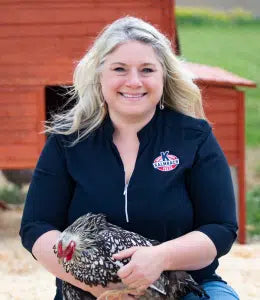Nutritional Needs of Mixed Flocks with Baby Birds

I’m sure we have all wondered if a flock feed is the right choice for our birds. Or, maybe you went to your local feed store to get chicks and ended up with a few baby ducks in the mix too. That may have made you wonder, “What feed is best for my flock now?” There are some distinct differences in the nutrient needs of different species of poultry.
What Are the Biggest Differences in Nutrient Need?
Baby ducks grow extremely fast and can require 60 more kilocalories in each pound of feed compared to slower-growing baby chicks. Baby turkey poults will pack on enormous amounts of muscle and require about 40% more protein than baby chicks in the first few weeks of their lives. Baby ducks do not convert their nutrients to niacin very well, so they require extra niacin during their periods of rapid growth. With all of these differences, how can a poultry owner balance the nutrient needs of their mixed flock but still keep their feed manageable?
Why Would I Choose a Flock Feed?
The magic lies within a really great flock feed. When we formulate mixed flock feeds, we make sure to focus on the essential nutrients for each species of poultry that we want to feed. Then, we balance those nutrients against the needs of the other birds. There is definitely some compromise but, in the end, we have a really well-balanced feed that will work for many different scenarios and many different types of poultry.
Feeding Ducks and Chickens Together.
Chicken and duck mixed flocks are probably the most popular in many of our backyard flocks. As we have discussed in previous articles, baby ducks do grow faster than baby chicks. They also have some unique nutritional requirements. Niacin is a B-vitamin (B3) and most B-vitamins are used to help convert food into energy. Ducklings usually require about 20-60% more niacin than baby chicks and that is because ducks grow extremely fast and they are not very good at converting their other nutrients to niacin. Ducks that are deficient in niacin may develop leg deformities that can affect how they walk. Because of these unique requirements, you want to choose a high-quality flock feed that specifically mentions ducks as one of the species in the purpose statement or in the feeding directions. This insures that the unique nutrient requirements of ducks were considered when the feed was formulated.
What If I Have Turkeys or Gamebirds in My Flock?
Before we dive into nutrient needs, I encourage anyone that wants to have turkeys in a mixed flock to do your research on Blackhead Disease.
Turkeys and gamebirds have very high nutrient requirements when they are babies. Turkey poults require 40% more protein than chicks intended to become layers. They also require a lot of energy to support their rapid growth. Unless you are raising slow-growing heritage varieties, the gap between the nutrient requirements for turkeys/gamebirds and chicks is actually too wide for a good compromise. This is why starting turkeys and gamebirds on a feed specifically formulated for those species is probably best for those birds. You may have to feed turkeys and gamebirds separately from other species of poultry for the first 3-6 weeks of life to give them the best start.
What Should I Feed My Adult Mixed Flock?
Most of the differences that I have mentioned in this article are a result of rapid growth that occurs in the first few weeks of a bird’s life. Each species grows differently and has different nutrient needs during those times. Do you remember how much your kids ate during a growth spurt? Poultry do the same thing! However, once those birds reach adulthood, most species actually have quite similar nutrient requirements. For example, an adult laying duck actually has very similar nutrient requirements compared to a laying hen. This is why most adult laying ducks do very well on complete layer diets.
Adult non-producing poultry – turkeys, roosters, gamebirds, retired hens – are all in a nutrient state that we refer to as maintenance. These birds still need good, balanced nutrition but their bodies are no longer in a state of rapid growth or production. Maintenance requirements are usually much lower than birds in the growth or production stage. A high-quality maintenance feed like Kalmbach 16% Flock Maintainer is the perfect option for mixed flocks. This feed still provides solid, quality nutrition to help your birds stay healthy, strong, and beautiful without excessive nutrient waste.
Keeping Mixed Flocks is Fun!
Keeping mixed flocks is fun! There is something so charming about seeing a nice blend of poultry out pecking around and enjoying a peaceful afternoon. We encourage all of our poultry lovers to keep expanding your flocks, keep learning about different types of poultry, and keep having fun! We are here to help you on every step of your poultry journey!
